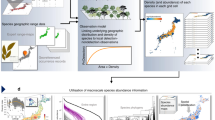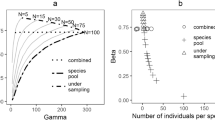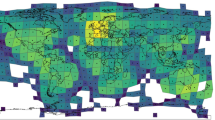Abstract
Species-area theory is an important concept in ecology. However, debates still surround the species-area relationship (SAR) or endemics-area relationship (EAR) and their relations to expected extinction rates. In this paper, I introduce the concept of overlap-area relationship (OAR) to link SAR and EAR. Two fundamental equations are derived from the relationship between the area and species number in a limited whole area A: 1) the sum of species number in area a and species number, here defined as endemics, in area A − a is the total species number in area A; 2) the number of species common to both areas a and A − a (overlapping species) equals the species number in area a minus the endemics number in area a. Thus, we should carefully consider the total area on which EAR depends, when estimating extinction rate based on SAR.
Similar content being viewed by others
Introduction
The species-area relationship (SAR) that links species richness with area is a fundamental concept as well as a useful tool in ecology and biodiversity conservation1. Since the SAR is affected by multiple factors at various scales, several functions, such as power law equation and random-placement model2,3,4, have been employed for this general convex-upward curve. However, much attention has been paid to statistical or mathematical formulation of the SAR, rather than its biological meaning and fundamental ecological theory3.
In addition, there has been a heated debate over the SAR and its derived concepts, such as the endemics-area relationship (EAR) and the extinction rate calculation5. He and Hubbell4 proposed that the sampling area difference between the SAR and the EAR was key for the overestimation of extinction rates and the backward SAR method (total species number in the total area A minus the species number remained in the area A − a after area a is cleared) was incorrect. For a long time, however, the effect of total area has been neglected, which is seldom shown in the SAR such as the power law format, even if it is an important parameter in the EAR calculation.
It requires the ecologists to clarify the relationship between the SAR and the EAR in the first place to settle the debate over the accurate calculation of extinction rate using the SAR and the EAR. In addition, as an important parameter in the SAR and EAR equations, area (including total area) should be carefully defined and measured. Here, I introduce the concept of the overlap-area relationship (OAR), the number of species that exist in both areas, to link the SAR and the EAR1. Two fundamental equations are derived to describe the general interrelations among the SAR, the EAR and the OAR.
Result
SAR, EAR and OAR
The general SAR equation, where the species number, Sa, is a function of area a, Sa = f(a), is expected to take the form of a convex-upward decelerating curve1,6. Similarly, SA−a = f(A − a) and SA = f(A), where A is the total area. The general EAR equation, Ea = g(a), where Ea is the number of species that disappear if area a is destroyed and g(a) is the function relating Ea and a. Similarly, EA−a = g(A − a) and EA = g(A). Obviously, SA = EA, where the total species number in area A equals the total number of species that will be removed if the whole area is destroyed. The OAR describes the number of species that exist in both areas a and A − a, thus, Oa = OA−a. In addition, OAR is also an important ecological concept to describe the species similarities of two (or many) habitats.
When area a is destroyed (species number for the SAR in the area a is Sa), some species are lost from the whole area A (species number for the EAR in the area a is Ea). However, some of the species Sa still exist in the area A − a (species number for the OAR is Oa). Thus, the general OAR equation is Oa = Sa − Ea (or Oa = Sa + SA−a − SA), meaning that the number of species that are common to both areas a and A − a equals the species number in area a minus the endemics number in area a (or minus the difference of species number between area A and area A − a). From Oa = Sa − Ea = Sa + SA−a − SA, we have Ea + SA−a = SA, or Sa + EA−a = SA, meaning that the sum of the species number in area a and the number of species that disappear when area A − a is destroyed is the total species number in area A. The interrelations among the SAR, the EAR and the OAR are shown in Fig. 1. In other words, SA is the union of sets Sa and SA−a, Oa is the intersection of sets Sa and SA−a and Ea is the difference set of Sa and SA−a.
For a + (A − a) = A and Sa + EA−a = SA, the SAR and the EAR are rotationally symmetric in the interval [0, A] and the center point is (A/2, SA/2) (Fig. 2, Oa ≠ 0, when A > a > 0). If Oa ≡ 0, Oa = Sa − Ea, the SAR curve and the EAR curve will coincide. The discussion of mirror images (axial symmetry) between the SAR and the EAR in He and Hubbel's paper4 is misleading, because what has been discussed is rather “rotational symmetry (point symmetry)”.
For the widely used convex-upward decelerating curve, the SAR curve should be enveloped by the straight lines  and Sa = SA in the interval [0, A] with Y axis (Fig. 2). And the EAR curve should be enclosed by the straight lines of
and Sa = SA in the interval [0, A] with Y axis (Fig. 2). And the EAR curve should be enclosed by the straight lines of  and Ea = 0 in the interval [0, A] with X axis. OAR is introduced here to link the SAR and the EAR, which is the D-value of SAR and EAR changing with area and the distance between the curves of SAR and EAR in the space. For the power law equation, Oa = caz + c(A − a)z − cAz, the value of the convex curve in the interval [0, A] peaks at a = A/2.
and Ea = 0 in the interval [0, A] with X axis. OAR is introduced here to link the SAR and the EAR, which is the D-value of SAR and EAR changing with area and the distance between the curves of SAR and EAR in the space. For the power law equation, Oa = caz + c(A − a)z − cAz, the value of the convex curve in the interval [0, A] peaks at a = A/2.
Discussion
In Fig. 3, the area that is required to find n species is smaller than the area that is required to remove n species, although the species that are found or removed are not necessarily the same. Thus, the SAR curve will be higher than or equal to the EAR curve, or Sa ≥ Ea (Oa = Sa − Ea ≥ 0), based on the comparison of their respective areas for the same species number. In addition, for the same species, although sampling difference between the SAR and the EAR areas exist in most cases, except that there is only one individual of the species, the extinction rate can still be calculated accurately based on either the backward SAR or EAR equations in the case of the random placement model, which will produce the same results4.
Apart from spatial heterogeneity, several other factors, such as incomplete sampling, small data sets (few data points) and inappropriate model (fit of a power law model to the SAR), may lead to overestimation or underestimation of extinction rates. Since the calculation of Sa doesn't use SA and the total species number SA can be obtained from the SAR equation, one more parameter (total area A) needs to be considered in the EAR equation Ea = SA − SA−a. For instance, in the power law equation for SAR, Sa = caz, the SAR has two parameters, c and z. The corresponding power law equation for the EAR, Ea = cAz − c(A −a)z, has three parameters, c and z, and A. Thus an incorrect total area A can lead to inaccurate estimation of extinction rates. In Fig. 4 (Oa ≠ 0, when A > a > 0), if total area is not identified accurately, when A′ < A (A the real total area, A′ is an incorrect total area), the calculation of extinction rate based on the backward SAR or EAR equation will be overestimated, no matter equation for the SAR or EAR is used. However, if the incorrect total area is larger than the real total area, the extinction rate based on the SAR or EAR is underestimated.
The relationships among the SAR, the EAR and the OAR have been explored. Thus, two fundamental equations, namely, Sa + EA−a = SA and Oa = Sa − Ea, are derived for the species-area theory, which can numerically describe the species numbers in the areas a and A − a. In addition, the SAR and EAR curves are rotationally symmetric in the space of Area vs. Number of Species. Because the EAR equation includes one more parameter than the SAR, i.e., total area A and its corresponding total species number SA, incorrect real total area will overestimate or underestimate the extinction rate.
References
Tjørve, E. & Tjørve, K. M. C. The species-area relationship, self-similarity and the true meaning of the z-value. Ecology 89, 3528–3533 (2008).
Arrhenius, O. Species and area. J. Eco. 9, 95–99 (1921).
Turner, W. R. & Tjørve, E. Scale-dependence in species-area relationships. Ecography 28, 721–730 (2005).
He, F. & Hubbell, S. P. Species-area relationships always overestimate extinction rates from habitat loss. Nature 473, 368–371 (2011).
Kinzing, A. P. & Harte, J. Implications of endemics-area relationships for estimates of species extinctions. Ecology 81, 3305–3311 (2000).
Tjørve, E. & Turner, W. R. The importance of samples and isolates for species-area relationships. Ecography 32, 391–400 (2009).
Acknowledgements
I warmly thank Xuejun Dong (since June 6, 2011), Janet Patton and Bob Patton at North Dakota State University for the helpful suggestions for the manuscript revision. I appreciate the critical comments and encouragement of Dr. James Rosindell (since October 12, 2011) at University of Leeds, Dr. Robert May at University of Oxford and anonymous reviewers. The work is supported by the Tsinghua University, Texas A&M University-Kingsville, Green Design and Planning and Institute of Plant Quarantine of Chinese Academy of Inspection and Quarantine (Pest Risk Analysis Specific Project and Young Innovative Team Program).
Author information
Authors and Affiliations
Ethics declarations
Competing interests
The author declares no competing financial interests.
Rights and permissions
This work is licensed under a Creative Commons Attribution-NonCommercial-NoDerivs 3.0 Unported License. To view a copy of this license, visit http://creativecommons.org/licenses/by-nc-nd/3.0/
About this article
Cite this article
Pan, X. Fundamental equations for species-area theory. Sci Rep 3, 1334 (2013). https://doi.org/10.1038/srep01334
Received:
Accepted:
Published:
DOI: https://doi.org/10.1038/srep01334
This article is cited by
-
Application of fundamental equations to species−area theory
BMC Ecology (2016)
-
On the decline of biodiversity due to area loss
Nature Communications (2015)
-
Matthew effect in counting the number of species
Biodiversity and Conservation (2015)
-
Habitat management varying in space and time: the effects of grazing and fire management on marshland birds
Journal of Ornithology (2015)
-
Reconstruct Species-Area Theory Using Set Theory
National Academy Science Letters (2015)
Comments
By submitting a comment you agree to abide by our Terms and Community Guidelines. If you find something abusive or that does not comply with our terms or guidelines please flag it as inappropriate.







